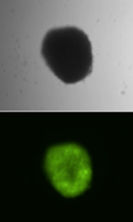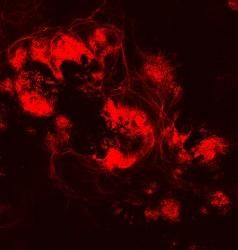Research casts doubt on circulating stem cells
Bone marrow-derived cells fail to meet high expectations says Bonn study
Advertisement
Adult stem cells taken from bone marrow are the "shooting stars" of their field. Many research scientists have been speculating that the cells might be able to pass through the blood into diseased organs and replace defective tissue. Such cells are seen as the potential key to the treatment of certain muscle diseases. However, a study currently being conducted at Bonn's University Clinic has produced some sobering findings: although the cells are able to migrate into the muscle fibres, they do not generally take on any tissue-specific functions. This, according to the Bonn medical scientists, means the cells would not serve as a substitute for defective muscle cells. The study is reported in PNAS.
Bone marrow constantly produces stem cells from which, among other things, the white and red blood corpuscles are formed. The dream of many scientists is to breed other types of tissue from bone marrow-derived cells. In recent years a great deal of hype has been generated around the idea of a "cellular jack of all trades" - not least because some studies gave grounds for hope. Using irradiation techniques, researchers managed to destroy the bone marrow in mice and replace it with cells which became green-fluorescent thanks to a genetic addition. A short time later they then discovered green-fluorescent nerve cells in the mice's brains. This appeared to them to be evidence that the stem cells circulating in the blood could actually transform themselves into nerve tissue. It looked like the discovery of a completely new mechanism: the repairing of tissue using stem cells from the blood stream.
What excited medical scientists most was the idea that the body had at its disposal a kind of "mobile task force" of repair cells, constantly moving through the body and replacing damaged tissue. Even severe diseases like Duchenne muscular dystrophy (DMD), which destroys all the body's muscles, appeared to be potentially treatable - indeed, by the simple means of transplanting healthy bone marrow. For boys, DMD is the second most common hereditary disease. Due to a genetic defect, the muscles fail to produce properly functioning dystrophin, an important muscle protein. Those affected develop progressive muscle wasting. They only have a life expectancy of 15 to 20 years.
"In mice with DMD we have replaced the bone marrow with healthy marrow marked by a fluorescent gene," explains Bonn physiologist Professor Dr. Anton Wernig. The hope of the medical scientists is that the transplanted stem cells will find their way through the blood into damaged muscle fibres where they can produce functioning dystrophin. The Bonn researcher team was in fact able to detect green-fluorescent stem cell nuclei in the muscle fibre for several months after the bone marrow transplantation. And, as Professor Wernig emphasises, "they were found in numbers that would have had to bring a significant improvement to the condition of the muscle." The next step was to find out whether the stem cell nuclei were actually producing muscle proteins. Here, the results were negative: "If at all, very few nuclei produced dystrophin - in any case, far too few to achieve any improvement in the condition." The physiologist concludes, "Although the cells do merge with the defective muscle, we suspect that they remain silent and cannot set off the hoped-for 'muscle programme'." In other words, the bone marrow-derived cells are not converted into functioning muscle fibre.
The myth of a circulating jack of all trades
The reason is probably that in nearly all cells released into the blood from bone marrow many genes are permanently "switched off" and the cells cannot simply be switched back on again. After all, what comes from bone marrow is generally blood and not muscle tissue. The story of a "jack of all trades" circulating via the blood stream throughout the body and repairing, wherever needed, any type of tissue is, unfortunately, a myth. In practice their impact is, at best, minimal.
The somatic cells mark genetic traits believe by the body to be no longer needed by sticking a label on them - a sort of molecular "Don't use!" sign. "We have tried to remove this label by chemical means, too, in an effort to get the nuclei of the bone marrow-derived cells to start producing muscle proteins again," says Professor Wernig. "While we were able to activate dystrophin production in the muscle, the effect was nowhere near the level needed to combat the disease. But we shall continue working on this and try to awaken those 'sleeping beauties', the nuclei."
The Bonn physiologist believes that it is necessary to dampen the very high expectations held by some colleagues: "In my view, many of the studies using bone marrow-derived stem cells have so far been interpreted over-optimistically." The experiments with green-fluorescent nerve cells would seem to be one such case: "The bone marrow-derived cells have probably migrated from the blood into the brain where they do not change into nerve cells but blend with the neurones that already exist there." In this case, the presumed stem cells would only have coloured a few brain cells green.



















































